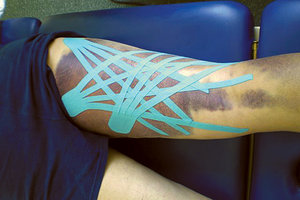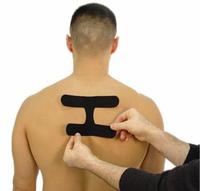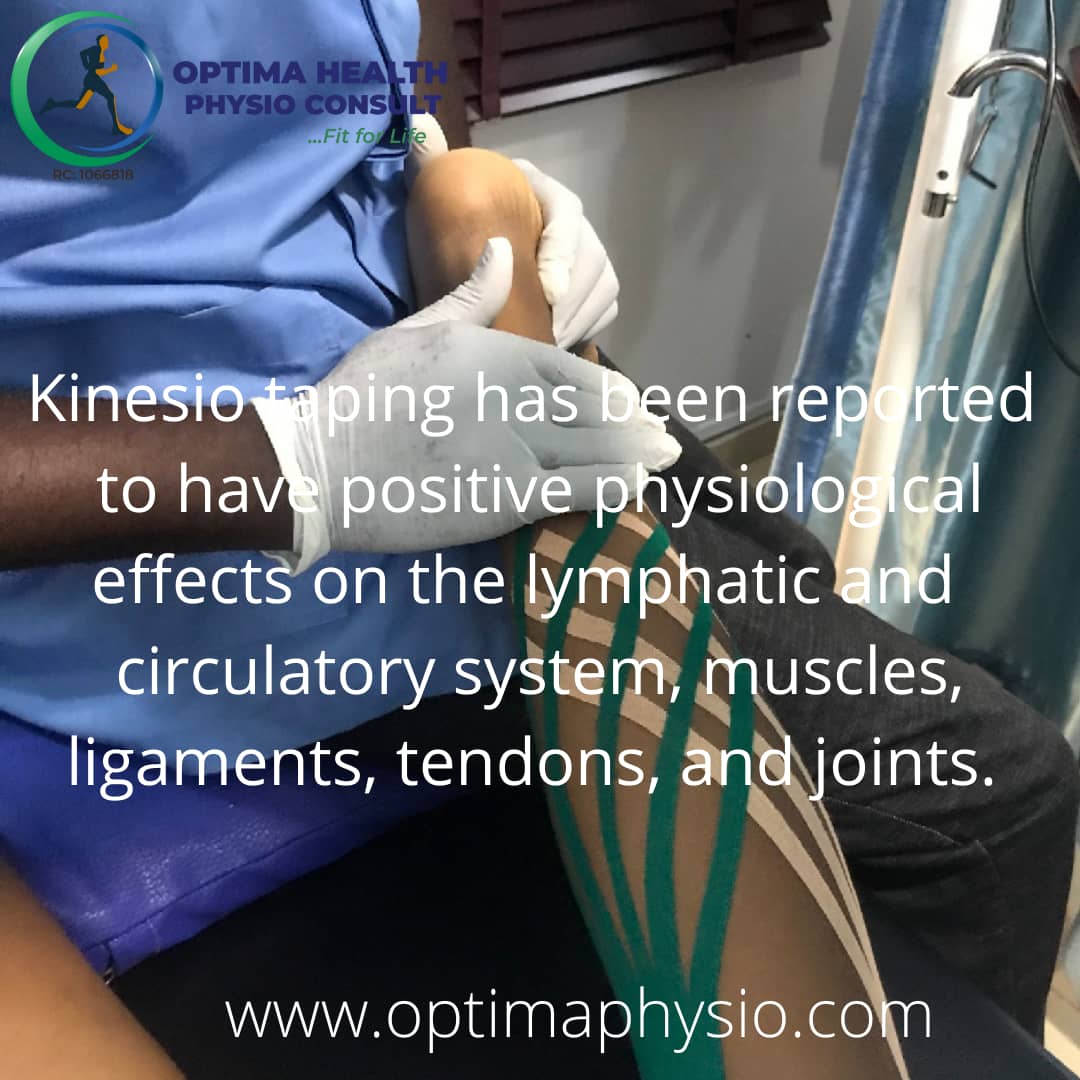What is Kinesio Taping for Physical Therapy?
Chiropractor Dr. Kenzo Kase developed Kinesio taping in 1979. This latex-free tape uses glue that is heat activated so it is wearable for a few days, even when a patient exercises or showers. In a nutshell, it can be used to help reduce pain, re-educate the neuromuscular system, increase circulation, optimize performance and prevent injuries.
Kinesio taping is a rehabilitative method and in order to be used properly should be applied by a trained professional with appropriate knowledge of anatomy and muscle fibers. Since it’s a technique, the amount of pull, the direction of the tape and even the length of tape is customized to specific physical therapy goals. What’s cool about the tape is that it’s not restrictive, so it provides support without inhibiting range of motion.
How to use Kinesio tape
Kinesiology tape can be applied in different ways to achieve different results. There are three main techniques:
1. Neurosensory –to relieve acute or chronic pain.

Neurosensory Kinesio Taping for Elbow.
2. Microcirculatory – to reduce swelling and bruising by enhancing lymphatic drainage.

Neurosensory Microcirculatory Structural
3. Structural – to support injured areas and encourage proper postural and movement patterns.

Structural Kinesio Taping
Each of these techniques requires a different combination of two factors:
1. The amount of stretch in the affected muscle or muscle group.
2. The amount of stretch in the tape as it is applied.
With that in mind the following are general guidelines for each of the three taping techniques:
1. Neurosensory – stretch the muscle, not the tape
2. Structural – stretch the tape, not the muscle
3. Microcirculatory – stretch the muscle and the tape
In a nutshell, the technique involves applying tape directly over an injured area, including its perimeter. In most cases, the muscles should be held in a stretched position while the tape is applied. Unless the goal is to provide structural support, the tape itself does not usually require additional stretching as it is applied. The natural elasticity of the tape creates a gentle lifting action of the skin, which activates both neurological and circulatory healing mechanisms. Also reducing pressure on pain receptors can rapidly relieve acute pain, while improving blood flow and lymphatic drainage which will reduce swelling and facilitate healing.
But perhaps the thing that rocks most about Kinesio tape is that while patients wear the tape, they are reminded to move in healthier ways to improve posture and prevent injuries. This reminder is incredibly important when trying to retrain patients to move in ways that sustain health and wellness.
5 Benefits of Kinesio Taping
The goals of kinesiology taping are to improve circulation, support muscles, foster healing, and help prevent injury or further injury.
Five of the top benefits of using this method are:
- Decreased Pain: By gently applying pressure, kinesiology tape helps to disrupt and dissipate pain.
- Increased Circulation and Decreased Inflammation: The tape can help remove congestion while allowing efficient circulation of oxygenated blood and lymphatic fluids. Circulation flushes out irritants, thereby reducing inflammation and chemical buildup and fostering a speedy recovery.
- Improved Posture and Muscle Support: Taping areas that veer away from correct posture can help gently support proper posture. Proper taping also enables weak muscles to function efficiently, reduces pain and fatigue, and protects against cramping, over-extension, and over-contraction.
- Improved Athletic Performance: By supporting unstable joints and delivering slight pressure to “sleeping” muscles, taping can prompt higher performance. Unlike other assistive devices that can lead to dependence on them for stability and support, kinesiology tape trains the body to become independent and efficient.
- Supported endogenous analgesic system: The tape enables the body’s own healing mechanisms to work in the recovery process. (“Endogenous” means “internal,” and “analgesic” means “relieving pain.”)
Who Can Be Helped by Kinesio Taping?
Any soft-tissue injury or pain can benefit from kinesiology taping – everyone from a young athlete with overused or injured muscles to an elderly person with a degenerative joint disease.
Kinesio taping can help:
- Those whose professions involve hard physical labor and repetitive movements (construction workers, factory workers, gardeners, mechanics, miners, secretaries, etc.)
- People who sit and work at a desk for long periods every day, or who have sedentary lifestyles.
- Athletes and other physically active people, including cyclists, golfers, joggers, and other exercise enthusiasts or those involved in sports.
- People who suffer the after-effects of bad posture, poor sleeping habits, etc.
- Joint pain sufferers.
- People suffering from joint, muscle, or tendon injuries of any kind, whether due to disease or accidents.
Who Can Help With My Muscle Pain and Joint Issues?
Kinesio taping has been reported to have positive physiological effects on the lymphatic and circulatory system, muscles, ligaments, tendons, and joints. Our specialized staff can help explain how to best utilize this method to alleviate your pain and other orthopedic issues.
The staff at Optima-Health Physio Consult utilizes both cutting-edge therapies and complementary treatments to address a variety of orthopedic conditions. For more information or to schedule a consultation, call (+234) (0)9096259209 or fill out our easy-to-use online appointment request form. We look forward to helping you feel better and have a more pain-free lifestyle.

